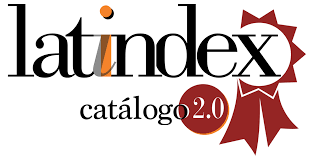Misión, Visión y Valores. Elementos determinantes en la construcción de un propósito diferenciador para las organizaciones del Tercer Sector/Mission, Vision and Values. Determining elements in the construction of a differentiating purpose for Third Sector
DOI:
https://doi.org/10.5783/revrrpp.v12i23.749Keywords:
Tercer Sector, ONG, Propósito, Misión, Visión, Valores, Comunicación Institucional.Abstract
Resumen
El Tercer Sector en España se caracteriza por su elevado grado de atomización, por lo que la diferenciación juega un papel determinante ya que la supervivencia de las ONG radica en la identificación con las causas que las ocupan por parte de públicos tan relevantes como los colaboradores, socios o donantes. Por este motivo se considera fundamental visibilizar cómo las ONG se autodefinen y se presentan ante sus stakeholders a través de la formulación de la misión, la visión y los valores, como elementos fundamentales en la comunicación de sus propósitos. En consecuencia, este artículo, mediante la técnica cualitativa del análisis de contenido, centra la atención en las memorias y sitios web de cinco de las organizaciones con mayor presencia en España: Cáritas Española, Cruz Roja Española, Fundación OXFAM Intermón, Fundación Save The Children España y Fundación UNICEF-Comité Español. Todas ellas reconocidas por la Agencia Española de Cooperación Internacional para el Desarrollo (AECID), pertenecientes a la Coordinadora de ONGD (CONGD) y posicionadas en términos de notoriedad entre las diez primeras por parte del público según el estudio elaborado por Kantar Millward Brown y la AEFr, que analiza la evolución del perfil del donante español y sus relaciones con las ONG bajo el título La colaboración de los españoles con las entidades no lucrativas. Perfil del donante 2018 (2019). Con el objetivo de conocer el nivel de diferenciación y el grado de especificidad en la autodefinición de cada caso, este artículo procura un análisis comparativo que permita localizar similitudes y diferencias en el discurso de dichas organizaciones. Sin embargo, los resultados de la investigación revelan que, en detrimento de la diferenciación, la retórica utilizada y las estrategias discursivas de la muestra, responden en mayor grado a mensajes reducionistas y poco diferenciadores.
Palabras clave: Tercer Sector, ONG, Comunicación Institucional, Transparencia, Propósito.
Abstract
The Third Sector in Spain is characterized by its high degree of atomization, for which differentiation plays a determining role since the survival of NGOs lies in the identification with the causes that occupy them by public as relevant as the collaborators, partners or donors. For this reason, it is considered essential to make visible how NGOs define themselves and present themselves to their stakeholders through the formulation of the mission, vision and values, as fundamental elements in the communication of their purposes. Consequently, this article, through the qualitative technique of content analysis, focuses on the reports and websites of five of the organizations with the greatest presence in Spain: Cáritas Española, Cruz Roja Española, Fundación OXFAM Intermón, Fundación Save The Children Spain and UNICEF Foundation-Spanish Committee. All of them recognized by the Spanish Agency for International Development Cooperation (AECID), belonging to the Coordinator of NGDOs (CONGD) and positioned in terms of notoriety among the top ten by the public according to the study prepared by Kantar Millward Brown and the AEFr, which analyzes the evolution of the profile of Spanish donors and their relations with NGOs under the title The collaboration of Spanish with non-profit entities. Donor Profile 2018 (2019). In order to know the level of differentiation and the degree of specificity in the self-definition of each case, this article seeks a comparative analysis that allows locating similarities and differences in the discourse of these organizations. In this context, it is especially important to identify, analyze and compare the rhetoric used to present the mission, vision and values as elements that can be condensed into the purpose and determine the self-definition of NGOs. Together with the descriptive scope of the work regarding these basic elements of corporate identity, this research allows knowing the degree of differentiation with which organizations present themselves and pointing out opportunities for improvement in the formulation and communication of their purposes. The results of the research reveal that, to the detriment of differentiation, the rhetoric used and the discursive strategies of the sample respond to a greater degree to reductionist and little differentiating messages. And the enunciation of the purpose appears disintegrated in various supports, hindering its communicative power. It is also cause for reflection to observe how, despite the diversity of each NGO regarding fields of action, users, beneficiaries, territories in which it operates, etc., they all present their main values around solidarity, integrity and transparency. With what is deduced a lack of depth, even of intention, when it comes to exactly identifying highly differential values. As mediating actors and agents of change, NGOs must make use of creativity not only in their speeches, but also in the design of conversation plans to strengthen their symbolic capital. The evolution of institutional communication must combine the communication plan with the conversation plan. And the entities should establish an "editorial line" guided by their objectives and purpose to produce content associated with their activity, as well as exploit their informative and dialogue-generating capacity to strengthen engagement with their stakeholders.
Keywords: Third Sector, NGO, Institutional Communication, Transparency, Purpose.
Downloads
References
AECID (s.f.). Portal web AECID Calificación. http://www.aecid. es/ES/la-aecid/nuestros-socios/ongd/calificacion
ASOCIACIÓN ESPAÑOLA DE FUNDRAISING (2017). Asociación Española de Fundraising: Trabajando para el desarrollo de la Captación de Fondos en España. Recuperado el 1 de abril de 2022 de, https://www.aefundraising.org
ALLOZA, A. Y FONTÁN, C. (2018). El propósito corporativo como palanca para la transformación organizacional. Economía Aragonesa, 65, 73-87.
ARÉVALO, R. I. Y ORTIZ, H. (2018) Comparativo de modelos de relaciones públicas en organizaciones del tercer sector de México, Chile. Revista Internacional de Relaciones Públicas, 8(15), 85-106. http://dx.doi.org/10.5783/RIRP-15-2018-06-85-106.
BALAS, M. (2010). La gestión de la comunicación en el Tercer Sector. Análisis de la imagen percibida de las organizaciones del Tercer Sector. (Tesis Doctoral). Universitat Jaume I de Castellón, España.
BARDIN, L. (1996). Análisis de contenido. México D.F.: Akal.
CAMPBELL, A. (1997). Mission statements, Long Range Planning, Vol. 30(6), 931-932.
CAPRIOTTI-PERI, P. (2009). Branding Corporativo. Fundamentos para la gestión estratégica de la Identidad Corporativa. Chile: Colección de Libros de la Empresa.
CAPRIOTTI-PERI, P. (2021). DircomMAP. Dirección Estratégica de Comunicación. Barcelona: Bidireccional.
CARDONA, P. y REY, C. (2005). Dirección por Misiones. España: Ediciones Deusto.
CÁRITAS ESPAÑOLA (s.f.). Cáritas Española. https://www.caritas.es
CÁRITAS ESPAÑOLA (2018). Compartiendo compromiso: Memoria 2017. Recuperado el 4 de abril de 2021 de, https://caritas-web.s3.amazonaws.com/main-files/uploads/2018/09/MEMORIA- CARITAS_2017_web.pdf
CARRERO, Y. B. (2019). Identidad Corporativa y los Valores Organizacionales, desde un Liderazgo de Avanzada. Revista Scientific, 4(14), 347-366. https://doi.org/10.29394/Scientific.issn.2542-2987.2019.4.14.17.347-366
CASTILLO-ESPARCIA, A. (2007). Relaciones Públicas en las organizaciones no gubernamentales. Sphera Pública,núm.7, 193-210. https://www.redalyc.org/articulo.oa?id=29720421012
COLLE, R. (2011). El análisis de contenido de las comunicaciones. Colección Cuadernos Artesanos la Latina/13, 9a ed., 102. España: Sociedad Latina de Comunicación Social.
CONGD (2018). Coordinadora de ONGD España. https://coordinadoraongd.org
CORPORATE EXCELLENCE Y CANVAS (2018). Aproaching the future 2018. https://canvasconsultores.com/wpcontent/uploads/2018/06/Approaching%20the%20Future%202018_.pdf
CRUZ ROJA ESPAÑOLA (s.f.). Cruz Roja Española. https://www2.cruzroja.es
CRUZ ROJA ESPAÑOLA (2018). Memoria de sostenibilidad 2017. http://www. cruzroja.es/principal/documents/16917/132401/Memoria+Sostenibilidad+2017/004 dd66e-c029-2aca-c82a-2eaf0303f4c2
DIRCOM (2019). Anuario de la comunicación 2018. España: Dircom.
DURÁN, P. y FERNÁNDEZ, M. (2010). La comunicación en las organizaciones del Tercer Sector. Revista Latina de comunicación social, 65, 595-603. http://DOI:10.4185/RLCS-65-2010-921-595-603
EAPN-ES y PLATAFORMA DEL VOLUNTARIADO DE ESPAÑA. (2019). Tercer sector de acción social, movilización social y voluntariado ¿trasformamos juntos? https://eapn.es/ARCHIVO/documentos/documentos/1552922367_transformando-juntos.pdf
GARCÍA, S. y SIMON L. D. (1997). La dirección por valores. El cambio más allá de la dirección por objetivos. España: McGraw-Hill.
GRUNIG, J. (2009). Paradigms of global public relations in an age of digitalisation. PRism 6(2). http://praxis.massey.ac.nz/prism_on-line_journ.html.
HERRANZ DE LA CASA, J. y CABEZUELO, F. (2009). Comunicación y Transparencia en las Organizaciones Sociales: los blogs como generadores de transparencia en las organizaciones no gubernamentales. Revista Ícono 14, 13, 172-194. https://www.redalyc.org/articulo.oa?id=552556589010
HERRMANN, F. (2004). Relaciones Públicas para ONG. Perú: Fundación Konrad Adenauer.
JOHNSON, G., SCHOLES, K. y WHITTINGTON, R. (2010). Fundamentos de estrategia. Madrid: Pearson-Prentice Hall.
KANTAR MILLWARD BROWN y AEFR (2019). La colaboración de los españoles con las entidades no lucrativas. España: Asociación Española de Fundraising.
MAGUREGUI, M.L., CORRAL, J. y ELECHIGUERRA, C. (2019). La identificación de los grupos de interés de las entidades sin fines de lucro en la emisión de información transparente. Revesco (131), 65-85. http://dx.doi.org/10.5209/REVE.62814
MATILLA, K. (2009). Conceptos fundamentales en la planificación estratégica de las Relaciones Públicas. España: UOC.
NOHLEN, D. y ZOVATTO G., D. (2002). Instituciones Políticas en su contexto: Las virtudes del método comparativo. Argentina: Rubinzal-Culzoni Editores.
NOS-ALDÁS, E. (2007). Lenguaje publicitario y discursos solidarios. España: Icaria.
ONDA CERO (2017, 9 de marzo). Unicef lanza una campaña para lograr que un día su trabajo no sea necesario. https://www.ondacero.es/noticias/espana/unicef-lanza-campana-lograr-que-dia-trabajo-sea-necesario_2017030958c150650cf2600f3f592ab3.html
ORTIZ, H. (2021). Comunicación Integral y transparencia en las organizaciones del tercer sector. Revista Internacional de Relaciones Públicas, 11(21), 5-26. http://dx.doi.org/10.5783/RIRP-21-2021-02-05-26
OXFAM INTERMÓN (s.f.). OXFAM Intermón. https://www.oxfamintermon.org/es
OXFAM INTERMÓN (2018). Mucho recorrido, mucho por recorrer (Memoria 2017-2018). Construyamos un futuro sin pobreza. https://cdn2.hubspot.net/hubfs/426027/Oxfam-Website/OxfamWeb-Documentos/memoria-Oxfam- Intermon-2017-2018.pdf
PALLARÉS‐RENAU, M. (2021). Aproximación a un modelo de medición de reputación corporativa para las Entidades del Tercer Sector de Acción Social. Determinación de Dimensiones, Variables y Públicos (Tesis Doctoral). Universitat Jaume I de Castellón, España.
PWC (2018). Radiografía del Tercer Sector Social en España: retos y oportunidades en un entorno cambiante. España: PwC Fundation https://www.pwc.es/es/publicaciones/tercer-sector/fundacion-pwc-tercer-sector-social-2018.pdf
QUINTANA-PUJALTE, A.L. (2021). Relaciones públicas y tecnología: la interactividad como punto de encuentro entre las ONG y sus públicos. Revista Internacional de Relaciones Públicas, 11(21), 49-68. http://dx.doi.org/10.5783/RIRP-21-2021-04-49-68
REGADERA, E., GONZÁLEZ, H., y PARICIO, M.P. (2018). Los medios en la gestión de la comunicación de las ONG en tiempos de crisis: oportunidades para el cambio social. (OBS*) Journal, 12(3), 83-105. https://hdl.handle.net/10171/56441
REY, C., BASTONS, M. Y SOTOK, P. (2019). Purpose-driven organizations. Management ideas for a better world. Suiza: Palgrave Macmillan.
ROJAS ORDUÑA, L. (2012). Relaciones Públicas: La eficacia de la influencia. España: ESIC Editorial.
SANTOLINO, M. (2010). Recuperando la esencia: las ONGD como agentes de comunicación para el cambio social. Plataforma voluntariado, pp. 221-256. https://plataformavoluntariado.org/wp-content/uploads/2018/10/recuperando-la-esencia- las-ongd-como-agentes-de-comunicacion-para-el-cambio-social.pdf
SAVE THE CHILDREN (s.f.). Save the Children https://www.savethechildren.es
SAVE THE CHILDREN (2018). Memoria anual 2017. https://www.savethechildren.es/sites/default/files/imce/docs/memoria_anual_2017.pdf
UNICEF (s.f.). Unicef Comité Español. https://www.unicef.es
UNICEF (2017, 9 de marzo). Cierra UNICEF. Unicef_es [Twitter]. https://twitter. com/unicef_es
UNICEF (2018, Julio). La memoria de UNICEF Comité Español 2017: Contigo cambiamos la vida de millones de niños. https://www.unicef.es/sites/ unicef.es/files/comunicacion/MEMORIA_UCE_2017.pdf
VIDAL, P. (2002). Libro blanco del tercer sector cívico-social en Catalunya. España: Centre d’estudis de Temes contemporanis. https://dokumen.tips/documents/1b-document-de-sintesi-del-llibre-blanc-del-tercer-sector-civicosocial-a-catalunya.html?page=2
VILLAFAÑE, J. (2020, 2 de Octubre). El relato corporativo hoy. Asodircom y Villafañe & Asociados Consultores. http://www.villafane.com/wp-content/uploads/2020/09/El-Relato-Corporativo.pdf
WIMMER, R.D. Y DOMINICK, J.R. (1996). La investigación científica de los medios de comunicación. Una introducción a sus métodos. España: Bosch.
Downloads
Published
How to Cite
Issue
Section
License
Authors publishing in this journal agree to the following terms:
a. Authors retain copyright and grant the journal the right to be the first publication of the work as licensed under a Creative Commons Attribution License that allows others to share the work with an acknowledgement of authorship of the work and initial publication in this journal.
b. Authors may separately enter into additional arrangements for non-exclusive distribution of the version of the work published in the journal (e.g., placing it in an institutional repository or publishing it in a book), with an acknowledgement of initial publication in this journal.
c. Authors are allowed and encouraged to disseminate their work electronically (e.g. in institutional repositories or on their own website) before and during the submission process, as it can lead to productive exchanges, as well as earlier and higher citation of published work (see The Effect of Open Access).




